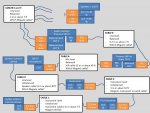Hi guys,
I'm planning to get myself recording again and buy some studio gear, but I got some questions regarding the signal path. Or actually, it's more about what types of cables I should be using in this scenario. I have thought of building the cables by myself, maybe Mogami, and for this signal path I'm actually sure only about the cable from the guitar to the overdrive pedal.
As I'm sure there's some pretty knowledgeable people reading these posts, I'd be very thankful if I could get some feedback and corrections for this signal path picture:
Mogami bulk cables can be found here: MOGAMI® - Bulk Cables
Cheers from Helsinki, Finland!
I'm planning to get myself recording again and buy some studio gear, but I got some questions regarding the signal path. Or actually, it's more about what types of cables I should be using in this scenario. I have thought of building the cables by myself, maybe Mogami, and for this signal path I'm actually sure only about the cable from the guitar to the overdrive pedal.
As I'm sure there's some pretty knowledgeable people reading these posts, I'd be very thankful if I could get some feedback and corrections for this signal path picture:
Mogami bulk cables can be found here: MOGAMI® - Bulk Cables
Cheers from Helsinki, Finland!
Attachments
Last edited:



